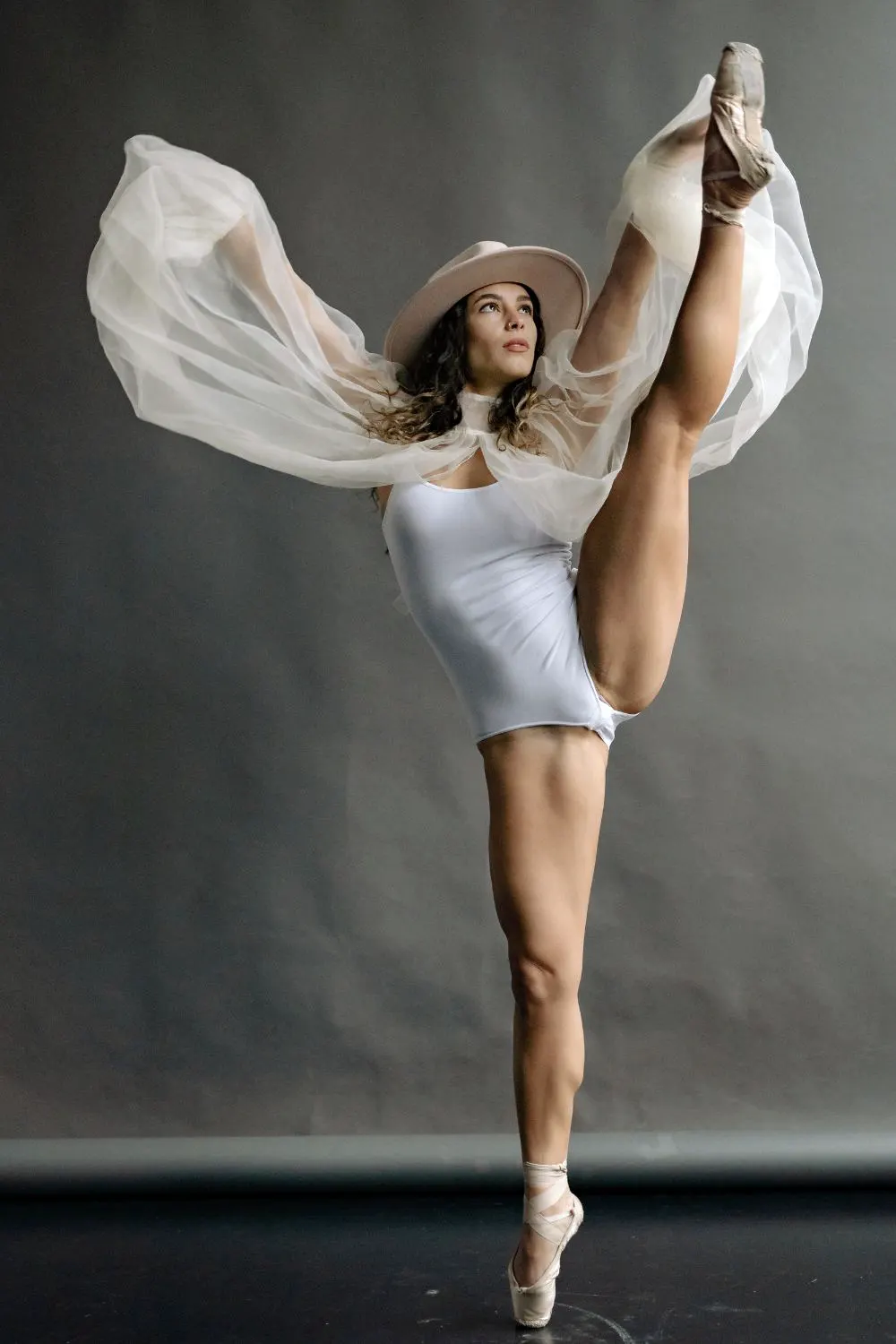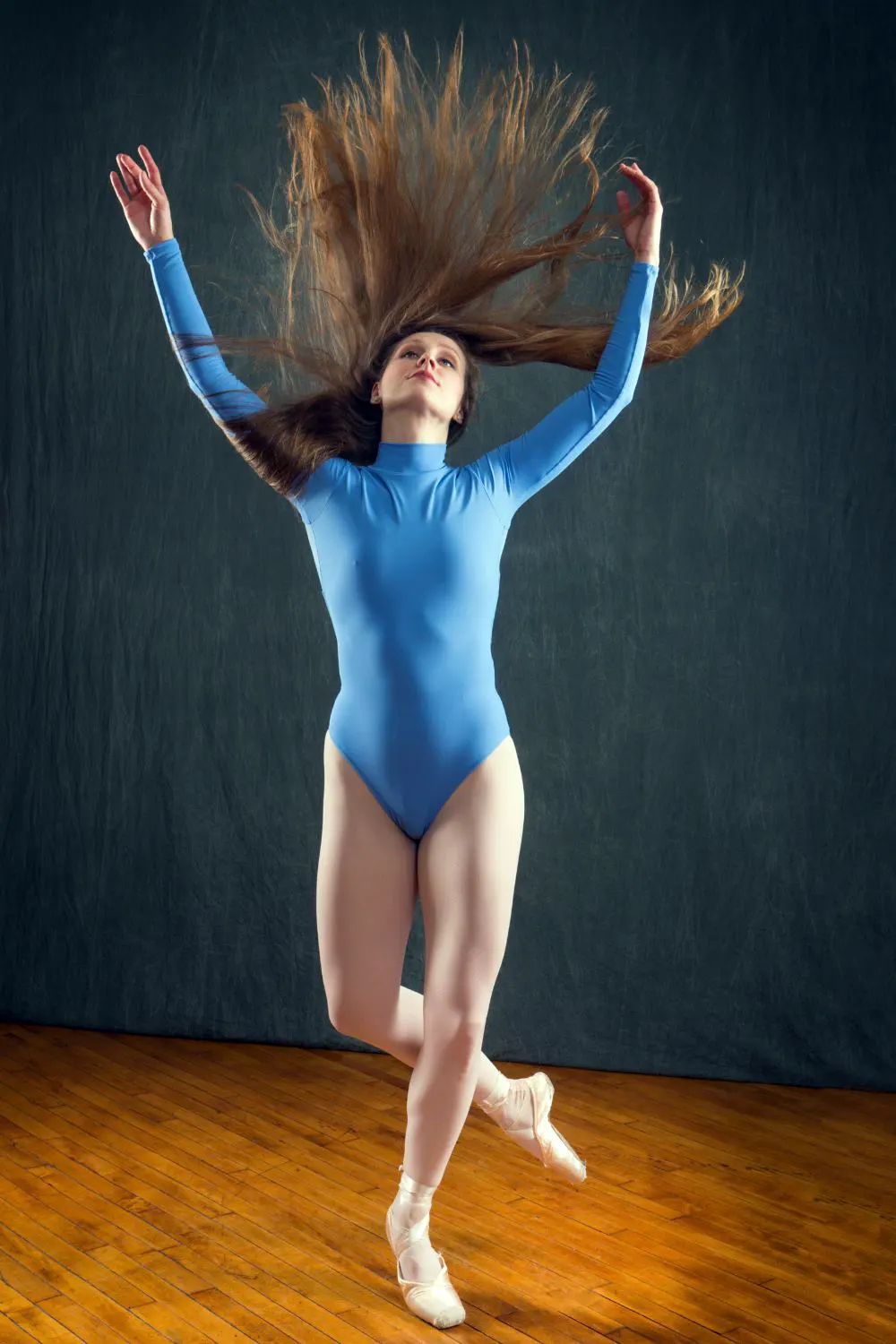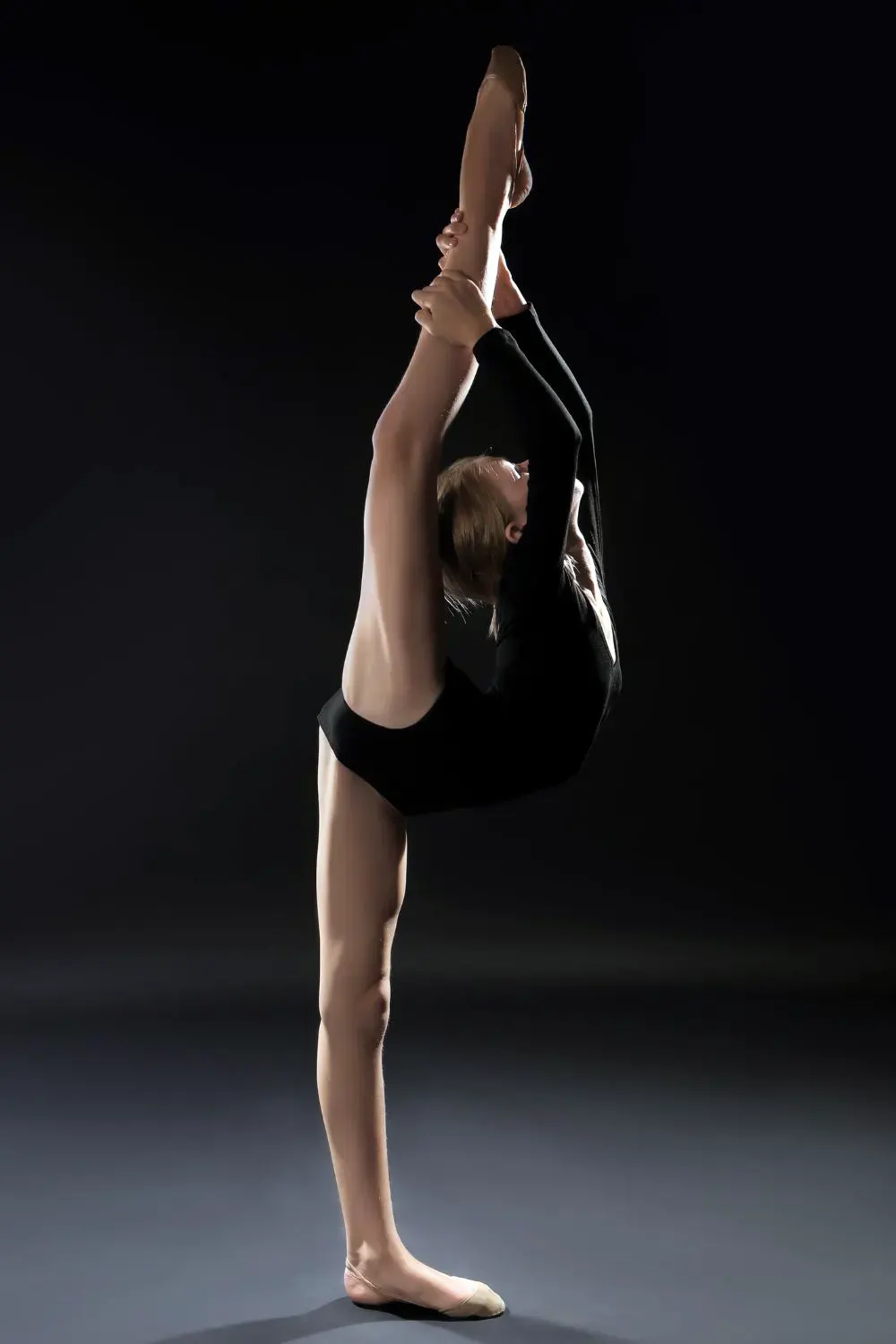Graceful yet strong female gymnasts dazzle us with their daring skills. But have you ever wondered why these athletes wear leotards? The skin-tight one-piece outfits are specially designed for the gymnasts to flip and twist freely.
Leotards provide maximum flexibility and range of motion for gymnasts. They do not restrict the gymnasts’ movement, which is crucial for performing complex skills. Leotards are made of elastic material that moves with the gymnast, allowing her to bend, stretch and tumble without limitation.
Safety is another reason why leotards are preferred. The snug-fitting leotards provide full freedom for movement without extra baggy clothing getting caught on equipment or slipping through the coach’s hands for spotting skills. Proper gymnastic leotards cover the full torso and do not have skirts attached. Leotards allow coaches to spot skills without their hands slipping. Covering the midsection also eliminates injuries to the stomach skin on the bars, beams, trampolines, and more.
In addition, leotards give the gymnasts a professional appearance during competition and practice. The streamlined shape of a well-fitted leotard enhances the lines and form of the skills. For the competition, elaborate embellishments like crystals, cut-outs, and mesh inserts are commonly used to accentuate the dramatics of the performance.
The above reasons simply show why leotards are the optimal choice of apparel for female gymnasts to achieve their maximum potential in training and competition. But the below list provides more reasons and information about female gymnasts’ choice to wear leotards.
Why do female gymnasts wear leotards?
To support movement, flexibility, and safety
Female gymnasts wear leotards for many practical reasons. They help gymnasts perform at their best.
Leotards allow freedom of movement and flexibility. They fit the body tightly without loose cloth getting in the way. This lets gymnasts bend and twist in the complex moves of their routines. The stretchy fabric allows a full range of motion for their arms, legs, and spine.
Leotards also increase safety and efficiency. Coaches and judges can easily see the gymnasts’ form and posture during tricks. The correct hips, spine, neck, and knees positions help prevent injuries.
Leotards are made for comfort. The breathable fabric helps keep gymnasts dry during competitions. The snug fit stops distracting hair strands near the neck.
While leotards come in stylish designs with sequins or rhinestones, their main purpose is to provide the functional benefits that help gymnasts perform at their highest level. Leotards’ tight fit, range of motion, safety, and comfort contribute greatly to a gymnast’s performance.

To ensure comfort during performances
Female gymnasts wear leotards to perform with comfort. They provide comfort in different ways, which help gymnasts perform better.
The material of leotards makes gymnasts feel comfortable. They are soft, breathable, and stretchy. This lets gymnasts concentrate on their routines without distraction.
Leotards prevent irritation. The snug fit stops hair strands from bothering gymnasts. Without leotards, hair could distract gymnasts.
Leotards absorb sweat to keep gymnasts dry. This allows gymnasts to focus on their performance instead of feeling sweaty and damp.
Leotards fit the body tightly and allow a full range of motion. Without loose cloth getting in the way, gymnasts can move freely and easily do complicated skills.
The comfort of leotards allows gymnasts to concentrate fully on their routines and movements. Gymnasts do not think about their clothing while performing.
Gymnasts wear leotards mainly for comfort during their performances. The design of leotards aims to minimize distractions and allow gymnasts to compete at their best.
To enhance the visual impact
Leotards add visual impact to female gymnasts’ performance. They come in many bright colors and stylish designs that draw the eyes of spectators and judges. The unique patterns and embellishments allow each gymnast to showcase their individual personality.
The tight fit of leotards emphasizes a gymnast’s body lines and musculature, bringing out the beauty of their athletic physique during the performance. This aesthetic element is particularly important in competitions where judges consider the overall presentation of a routine.
Brightly colored leotards with decorations make gymnasts highly visible on the gym floor. The visibility ensures judges and spectators can see a gymnast’s skills and movements clearly.
Leotards serve both visually appealing and practically functional purposes for gymnasts. The stylish designs complement the function of allowing freedom of movement.
Over time, leotard designs have evolved to include embellishments like sequins and rhinestones. The sophisticated designs now stand out and garner attention.
In summary, leotards contribute largely to aesthetics in gymnastics by enhancing a gymnast’s individual style, musculature, and visibility and combining both fashion and function for competitions. The result is a visually striking performance that leaves a strong impression.
To represent the history and culture of the Gymnast
Leotards have become a gymnastics tradition that female gymnasts follow. They have been part of gymnastics apparel for decades. Gymnasts have worn leotards in training and competitions for a long time.
Leotards help gymnasts appear uniform. Judges and spectators can easily identify gymnasts wearing similar leotards during events. Wearing a leotard shows professionalism and commitment to gymnastics. They are required for gymnasts.
Gymnasts wearing leotards pay respect to the history of their sport and honor gymnastics traditions. They can feature team logos and colors to build team spirit and unity. This boosts morale among teammates.
In conclusion, leotards represent the culture and history of gymnastics. Leotards have become customary for female gymnasts to wear during performances as a nod to the long-standing traditions of their sport.

For modesty reasons
Some female gymnasts choose to wear bodysuits for modesty reasons. In 2021, some German gymnasts wore unitards at an event instead of leotards as a statement against objectification.
Female gymnasts who wear bodysuits want to feel comfortable and less sexualized during performances. The revealing nature of leotards makes some gymnasts feel uncomfortable.
Bodysuits are allowed as long as the color matches the traditional leotard requirements. This provides gymnasts more coverage while still following the rules.
The decision to wear bodysuits is a personal choice by individual gymnasts, not a standard practice. Traditional leotards serve functional purposes like improving flexibility and wicking moisture.
Most gymnasts still wear leotards. Still, the use of bodysuits shows a shift in gymnastics culture towards greater athlete choice and respect.
In summary, while few gymnasts wear bodysuits for modesty, it remains a personal choice. Most gymnasts continue wearing traditional leotards as the standard attire.
To allow clearly see body alignments
Leotards give visibility that benefits gymnasts, coaches, and judges. Tight-fitting leotards allow coaches and judges to see a gymnast’s body alignment easily. This helps spot incorrect positions and skills difficulty properly.
Coaches and judges can clearly view the positions of a gymnast’s hips, spine, neck, and knees in leotards. Misalignments can lead to injuries or the deduction of points. Leotards help coaches and judges identify any issues with a gymnast’s form to prevent injuries.
Leotards promote uniformity among gymnasts, making them easier for judges to identify during competitions. Wearing a leotard shows the professionalism and seriousness required in gymnastics. They form part of the competition attire.
Brightly colored leotards with patterns make gymnasts highly visible to judges and spectators. This ensures their skills and movements can be seen clearly.
In summary, the fit of leotards provides important visibility for coaches, judges, and gymnasts themselves. This visibility aims for proper form, injury prevention, uniformity, and ultimately better performance.
To ensure freedom of movements
Leotards allow freedom of movement that helps gymnasts perform better. They are made of stretchy fabric that lets gymnasts move freely without restriction.
The tight fit of leotards ensures no extra cloth gets caught on equipment while spinning or flipped. The stretchy fabric of leotards allows full flexibility and range of motion needed for challenging skills.
The freedom of movement from leotards helps gymnasts execute routines with precision and control. The tight fit of leotards lets coaches and judges see body alignment clearly to check for mistakes.
Leotards are often breathable and wicking to keep gymnasts dry and comfortable during performance. This further improves freedom of movement.
In summary, stretchy leotards provide the freedom of movement that gymnasts need to perform complex skills with ease, flexibility, and proper form.
This helps accomplish top performance and comfort.
To promote team spirits
Female gymnasts wear leotards to build team spirit. They promote uniformity among gymnasts. Team members wearing the same attire feel like part of a unit. This unity helps teams stand out during competitions.
Leotards can feature team colors and logos, which boost team spirit and cohesion. This customization makes gymnasts feel like part of a group working for a common goal.
Wearing matching leotards create a shared experience for gymnasts. This fosters camaraderie and a willingness to work together towards goals. Leotards represent professionalism and dedication within gymnastics. This commitment creates a sense of team pride.
Leotards have long been gymnastics attire carrying the tradition of the sport.
Wearing them honors gymnastics history, which fosters team respect and unity.
In summary, leotards aid in building team spirit among gymnasts by promoting uniformity, shared experiences, commitment, tradition, and customization to reflect team affiliation. This unity helps performance on the competition floor.
To express their personal style
Leotards allow gymnasts to reflect their personal style. They come in many colors and designs that let gymnasts showcase their individuality. Gymnasts choose those that match their personalities and preferences.
Leotards serve both aesthetic and practical purposes for gymnasts. The stylish designs complement the functionality. Some gymnasts prefer simple leotards, while others wear leotards with complex patterns.
Over time, leotard designs have evolved to include bright colors, patterns, and embellishments to make them stand out more. Leotards enable gymnasts to express their creativity and personality. This makes some gymnasts feel more confident during competitions.
In conclusion, leotards allow gymnasts to show personal style while serving functional needs. The variety of leotards allows gymnasts to reflect their individual expression through design choices. This fashion aspect enhances the appeal of gymnastics performances.
As a symbol of gymnastics
Leotards have become a symbol intrinsically linked to female gymnastics. They represent the history, tradition, and legacy of gymnastics. Gymnasts have worn them for over a century.
Leotards’ design and tight fit make them instantly recognizable as gymnastics attire. They have become synonymous with the sport. Customized leotards featuring team colors and logos foster a united team identity. This strengthens the symbolic power of them.
Leotards are worn during performances and competitions where gymnasts showcase their skills. The presence of them symbolizes a gymnast’s dedication to the sport.
Leotards allow gymnasts to express their personal style and individuality through unique colors and designs. This contributes to the visual appeal of performances and the symbolic role of leotards.
In conclusion, due to their long tradition, recognizable appearance, association with competitions, and ability to express personality, leotards have become a symbol of athleticism, beauty, and grace within gymnastics. Leotards will likely continue as the representative attire of gymnasts for years to come.

Summary
Female gymnasts wear leotards for functionality, safety, comfort, aesthetics, tradition, modesty, visibility, freedom of movement, team spirit, fashion, and symbolism.
Leotards provide maximum flexibility and range of motion, allowing gymnasts to perform complex skills without restriction. They also enhance safety by eliminating loose clothing hazards and allowing coaches to spot skills effectively.
Leotards offer comfort by being breathable, absorbent, and preventing distractions. They add visual impact with bright colors and stylish designs, emphasizing the gymnast’s body lines and visibility on the gym floor.
Leotards have become a tradition in gymnastics, representing the sport’s history and fostering team spirit. Some gymnasts choose bodysuits for modesty reasons, while others prefer leotards for their functional benefits. The tight fit of leotards allows coaches and judges to assess form and posture accurately, ensuring proper alignment and injury prevention.
Leotards promote freedom of movement, which is crucial for executing complex skills. They also allow gymnasts to express their personal style and reflect team unity through customized designs.
Lastly, leotards have become a symbol intrinsically linked to female gymnastics, representing dedication, athleticism, beauty, and grace.
Overall, leotards provide the optimal choice of apparel for female gymnasts, combining fashion and function to enhance their performance and leave a lasting impression.
FAQ
How do I keep my nipples from showing in my leotard?
Use nipple covers or adhesive petals that are specifically designed to conceal nipples. These can be found at underwear stores or online. They are typically made of silicone or fabric and can be applied directly to the nipples to provide coverage.
Can girls swim in leotards?
While girls can technically wear leotards for swimming, it is not recommended. Leotards are designed for gymnastics and dance, not for use as swimwear. Swimsuits are specifically made with lightweight, quick-drying, and chlorine-resistant materials, unlike leotards. Moreover, leotards may not offer sufficient coverage or support for swimming activities. Therefore, choosing a proper swimsuit for swimming rather than using a leotard is better, as it may not provide the necessary functionality and comfort.
What do you wear under your leotard on your period?
When wearing a leotard on your period, you have a few options for additional protection. You can wear period-proof underwear that fits nicely under your leotard, providing leakproof protection. Another option is to carry extra leotards, shorts, pads, period panties, or underwear to change as needed throughout the day. If you use tampons, it’s recommended to wear a backup pad for extra security. Choosing what makes you feel most comfortable and confident is important.
How do gymnasts ensure that their leotards fit properly?
Gymnasts’ leotards should be a snug fit that creates a sharp silhouette without being too tight, have no creases, wrinkles, or snags, sleeves that are long enough, and comfortable for unrestricted movement. Also, it is important to choose a style that suits their body type and personal style and consider the purpose of the leotard (competition fit or comfort fit).
Do people wear bras under leotards?
Yes, some people choose to wear bras under their leotards, while others do not. The decision to wear a bra under a leotard often depends on personal preference, body shape, the fit of the leotard, and the style of dance or physical activity. Some dancers and gymnasts may wear a bra for added support, while others may find it unnecessary.



